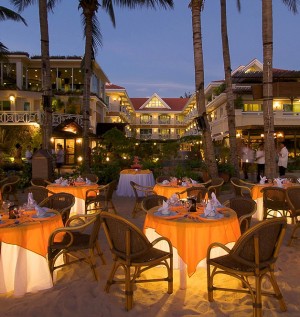A Visual Feast at Boracay Island
Southeast Asian beach hotspots rarely exist without something far more low-key and often surreal just around the corner from the decadence. It’s true all over Thailand, it’s true in Bali and after a recent trip to Boracay Island in the Philippines, I can attest that it holds true there as well.
Just hours after arriving, I found myself riding a bicycle for the first time in over a decade, accompanied by my Filipino girlfriend Kristine and a French guy named Yan, who we had met getting off of our plane. We’d procured the bikes smack in the middle of the main tourist drag, just across from D’Mall, the largest collection of tourist shops and restaurants on the island.
It being midday on a Friday, we had to weave through some pretty dense traffic, which on Boracay takes the form of gas-powered passenger “tricycles” and mini-trucks about the size of a large rhinoceros. The streets, even the main one we were pedaling along, aren’t the widest you’re likely to have seen, and pedestrians who’ve not yet discovered the more leisurely sand footpath along the beach, only clutter it more.
All of this makes it pleasantly jarring when you suddenly find the stores and tourists behind you, replaced by large, curving hills and sporadic local homes with their listless inhabitants happily watching traffic go by. It quickly becomes apparent why the tourist area is located where it is – most of the island is a series of jungle-lined ups and downs that wouldn’t accommodate the kind of rampant capitalism and partying that dominate the tourist center.
That is not to say that it’s particularly difficult to get around if you’ve got wheels of any kind – the main road provides an easily-followed circuit that can be completed in a short few hours. It’s well worth it to see the (relatively) untouched side of the island, which, for better or worse, hasn’t experienced the same consumer boom as the southeastern side.
The excited reactions of the locals, particularly the younger ones, imply that there aren’t a ton of people making this trip on a daily basis. The site of an interracial trio like ours winding around the increasingly empty road brought about laughter and greetings in plenty, especially when a hill would prove visibly challenging for one of us.
Eventually, the jungle breaks to reveal another beach on the remote and impoverished, but still gorgeous, midway point of the island circuit. We stopped to take it in.
There’s nary a foreign face to be seen there, and the homes, some with small convenience stores built into their fronts, are more ramshackle than anywhere we’d yet passed. Even the ocean there is a horse of a different color from the one along the main strip. Whereas the latter is perpetually calm, ideal for hours of hung-over lounging as it laps lazily at the white sands that mark its end, the water on the remote end is choppy and wild, tossing driftwood like an orca playing with a seal.
The general desolation, moody waves and location right off the main path, lend this beach the feeling of an abrupt end. It’s like standing on a soft, sandy cliff that just happens to be at sea level — which is not to say that the inhabitants are unaware of the booming tourism occurring on the other side. Within minutes of stepping off of our bikes and walking them toward the beach, we were beset by poor children trying to sell us souvenirs made from drift wood and coconuts.
It was yet another revisiting of the sad fact you find all over Southeast Asia – poverty never lurks far from the most amazing locales. In the Philippines that’s compounded by the country’s out-of-control birth-rate. Thanks largely to the influence of the Catholic Church, sexual education is practically non-existent and many ignore contraceptive options, creating a country where it’s not uncommon for 15 people to live in a house, half of whom are kids, and others are, as Sly & the Family Stone put it, babies making babies.
But I digress. These particular kids give out “I (heart) Boracay” bracelets “for being so handsome and beautiful,” which is nice, even if they are just trying to guilt the recipients into buying more expensive things like coin purses from them.
After one of the young salesgirls was reproached by a parent for being too young to sell (the older child was allowed to continue), we took in our full surroundings from the beach, focusing on a large dilapidated home built on the rocky peninsula which extends furthest into the sea. While doing so, we were approached by a massive, mentally handicapped man who was also looking for money. Cross-eyed and buck-toothed, with one hand curled permanently into a kind of claw, he was like the kind of unfortunate you’d see used as a gladiator in olden times, and he gave the impression that he had the kind of temper that would have been necessary for such a career.
(Article continued on next page)

